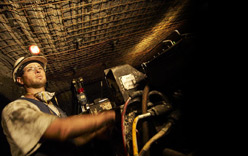Personnel and Material Transport
The mode of mine access (e.g. vertical shaft, inclined
drift, in-seam access via outcrop, etc) determines the nature of transport
systems used to transport personnel and materials into the mine (shaft
hoisting, drift haulage or rubber tyred vehicle access). However, the large
majority of mines today use diesel powered, rubber tyred vehicles (RTV's) to
transport both personnel and materials within the mine, largely because of the
flexibility of that system, with occasional caterpillar track vehicles for
special purposes.
It is ideal if all transport can be continuous from
surface to the work location, avoiding the need to change vehicle part way. Low
angle drifts or declines are popular for this reason but not always practical -
for deeper seams, low angle drifts would become too long.
In mines with a drift where rubber tyred transport
from surface is not practical, rail transport in the drift (with a haulage
winder and not locomotives) is the norm, with transfer to rubber tyred
transport at drift bottom. Most shaft mines also use rubber tyred transport
from pit bottom
The most popular type of materials transport involves the use of
diesel load/haul/dump (LHD) machines as tractors to tow materials trailers. It
is normal to have a "Quick Detach System" (QDS) fitting for the bucket so it
can be easily removed and replaced with various attachments for specific
purpose (e.g. a work platform for high work, a reeler for cables or conveyor
belts, etc). This results in a very versatile system where the prime movers can
also be used for excavation or clean-up work as well as material transport and
other miscellaneous work. With this system it is normal to have a different
type of vehicle for personnel transport, though personnel pods for the QDS are
available.
Some mines use a materials transport system which involves
materials pods carried by prime movers, designed to pick-up or drop-off the
pods without the need for the operator to leave the vehicle. While these
systems are successful, the mines generally require LHD machines for other work
as well.
Rail transport throughout mines was once the prevalent
system (before the development of suitable rubber tyred transports) and is
still used in some mines. Rail systems have some advantages in that they are
generally faster than free steered vehicles and one operator can transport
bigger loads. Much of this advantage is lost however at the rail end which
cannot be very close to the working faces. LHD machines or some similar
arrangement are then required to complete the trip.
The large equipment involved with modern longwalls
requires the use of specialized transport equipment. Because this equipment is
only required infrequently it is normal practice to hire such equipment as
required (or for mining groups to carry such equipment to share between several
mines).
There is a need for all types of systems to include
the ability to transport stretchers in a vehicle readily available at short
notice, in case of serious injury to personnel.
All diesel powered equipment used in underground coal
mines have to be fitted with devices to prevent the possibility of igniting
explosive gases and to keep air pollution to a minimum.

